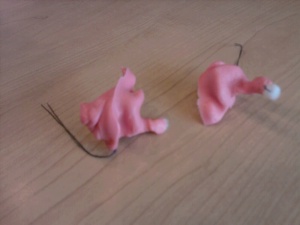
Photo credit http://www.octamom.com
Q: What’s an earmold?
A: When your infant or child is fit with hearing aids, they will need to have an earmold made. An earmold is a custom-made earpiece that will connect to his/her behind-the-ear hearing aid and will fit into your child’s ear.
Q: Okay. I’ve never seen an earmold before. What do they look like?
A: Good question. Earmolds are usually made of a hard acrylic or a soft silicone material. They can come in many different styles. The style is usually determined based on several factors, such as the size and shape of your child’s ear or ear canal and the severity of their hearing loss. Your child can help choose the color of the earmolds, which can be made with colored glitter or single/swirled colors.
Q: Awesome. Do I just pick those up at the drugstore? Where can I get earmolds?
A: Earmolds have to be custom made so they’ll stay in your child’s ear, so they have to be specially ordered, usually from an audiologist.
Q: If the earmolds are custom-made, how does the audiologist know the shape of my child’s ear?
A: You’re right. Every child’s ear and ear canal are unique. Even your child’s two ears can be very different from each other! The audiologist will need to make what is called an earmold impression of your child’s ear(s). An impression is a silicone model of the ear and ear canal. The factory will either make a cast or use a computer scan of the impression to build the earmold.
Q: How is an earmold impression made? Will it hurt my child?
A: It does not hurt at all! Here’s a step by step process on how impressions are made so you will know what to expect.
1) The audiologist will use an otoscope to look into your child’s ear. This allows her to check for wax blockages or to see if there is anything medically going on in the ear that would make taking an impression unsafe. In those cases, wax will have to be removed or your child will need to be medically cleared by a physician before impressions can be made.
2) The audiologist will use a small pen-shaped object with a lighted tip called an earlight to place a small piece of cotton into the ear canal. This is done to ensure the ear canal is completely blocked so that the impression material cannot go too far down into the canal or adhere to the eardrum. The cotton will have a string attached to it in case it needs to be removed before the impression is taken. The sensation experienced by most during this process is a tickle!
3) The audiologist will mix together two soft materials, which when blended will set up after several minutes to make a firm, almost rubbery material. He or she will then put the soft material into a large syringe and carefully inject the material into the ear canal. The most common sensation is a cool, sticky feeling when the material goes into the canal. The material will stay in the ear until it is firm enough to remove, which is usually about three to five minutes.
4) The audiologist removes the cast from the ear when it is done solidifying. They will then check the ear canal again using the otoscope to ensure all the material has come out of the ear and that everything inside the ear looks normal. The audiologist then fills out the order form and mails the impression(s) to the factory where they are made. Here’s a picture of what an earmold impression looks like after it’s done.

Photo credit http://www.lipreadingmom.com
Q: How long does it take to get the earmold?
A: It depends. Opting for rush service at the factory and/or FedEx-type delivery will shorten the wait time, although these services usually have added charges. The usual wait time is about 8-10 business days, sometimes sooner depending on how busy the factory is.
Q: How do the earmold and hearing aid fit together?
A: Another great question. Each earmold will have a tube attached to it. The tube goes through the front of the earmold and through the canal part of the earmold. At the hearing aid fitting, the audiologist will first put the earmold into the ear to check the fit and comfort of the mold. She will then hang the hearing aid over the ear and gauge where the ear hook of the hearing aid and the tube will meet. She will then trim the tube length and attach the hearing aid to the earmold tube. Sound can then travel from the hearing aid through the tube and through the earmold into the child’s ear. Here’s a picture of the earmold and hearing aid connected together.

Photo credit http://www.hearingaidblog.com
Q: What if the earmold doesn’t fit the first time? Will we have to buy another one?
A: No. If the audiologist determines that the earmold does not fit right when it is first fit to the ear, most factories allow a window of a few weeks’ time for an earmold to be remade so it’ll fit better. Sometimes a small modification can be made to the mold in the office by the audiologist without having to send it back to the manufacturer. If the fit is totally unsatisfactory a new earmold impression made need to be taken to ensure the best fit accuracy.
Q: Clearly my child’s ear won’t stay the same size as they get older. Will more more impressions have to be taken in the future?
A: Yes. The ear generally keeps growing until mid to late adolescence. An earmold that is too small for the ear or doesn’t fit right can cause problems like discomfort, whistling feedback or even less amplification to the ear. The earmold material itself may shrink or discolor with time which can also cause a less than ideal fit. Earmolds will need to be remade more frequently in earlier years than later years.


